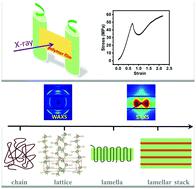当前位置:
X-MOL 学术
›
Soft Matter
›
论文详情
Our official English website, www.x-mol.net, welcomes your
feedback! (Note: you will need to create a separate account there.)
Recent advances in post-stretching processing of polymer films with in situ synchrotron radiation X-ray scattering
Soft Matter ( IF 2.9 ) Pub Date : 2020-03-05 , DOI: 10.1039/c9sm02554e Yuanfei Lin 1, 2, 3, 4, 5 , Wei Chen 1, 2, 3, 4, 5 , Lingpu Meng 1, 2, 3, 4, 5 , Daoliang Wang 1, 2, 3, 4, 5 , Liangbin Li 1, 2, 3, 4, 5
Soft Matter ( IF 2.9 ) Pub Date : 2020-03-05 , DOI: 10.1039/c9sm02554e Yuanfei Lin 1, 2, 3, 4, 5 , Wei Chen 1, 2, 3, 4, 5 , Lingpu Meng 1, 2, 3, 4, 5 , Daoliang Wang 1, 2, 3, 4, 5 , Liangbin Li 1, 2, 3, 4, 5
Affiliation

|
The stretch-induced structural evolution mechanism is a long-standing scientific question in the post-stretching processing of polymer films. X-ray scattering, especially a combination of small- and wide-angle X-ray scattering (SAXS/WAXS), provides a powerful method to study the hierarchical structure of polymer films. Recent advances in synchrotron radiation (SR) light sources and detection techniques allow one to measure the structural evolution of polymer films during post-stretching processing in real time with ultrahigh time resolution, which benefits the understanding on this topic. This review summarizes some recent investigations on post-stretching processing of polymer films, which combine in situ X-ray scattering techniques with purposely designed tensile apparatus in terms of three aspects: uniaxial stretching, biaxial stretching and stretching with chemical reactions. Concerning the polymer bulk, traditional deformation mechanisms like stretch-induced crystallization (SIC), crystal slipping, phase transition and melting–recrystallization are discussed for the uniaxial and biaxial post-stretching of polymer films. New deformation models have been developed to focus on the structural evolution on the length scale of lamellar stacks, which consider the potential microphase separation of the interlamellar amorphous phase and microbuckling. For solution systems, the coupled effects of the mechanical work from external force and the chemical potential from possible chemical reactions are taken into account for the structural evolution during stretching in solution. Roadmaps of structural and morphological evolution in the processing parameter space (i.e., temperature, stress, strain and the concentration of additive in the bath solution) are eventually constructed for precursor films. The accumulation of a structural evolution database for post-stretching processing of polymer films can be expected to provide a helpful guide for industrial processing for high-performance polymers in the near future.
中文翻译:

原位同步辐射X射线散射对聚合物薄膜进行后拉伸加工的最新进展
在聚合物膜的后拉伸加工中,拉伸诱导的结构演变机理是一个长期存在的科学问题。X射线散射,特别是小角度和广角X射线散射(SAXS / WAXS)的组合,为研究聚合物薄膜的分层结构提供了一种有力的方法。同步加速器辐射(SR)光源和检测技术的最新进展使人们能够以超高的时间分辨率实时测量拉伸后处理过程中聚合物膜的结构演变,这有助于对该主题的理解。这篇综述总结了有关聚合物薄膜的后拉伸加工的一些最新研究,这些研究是原位结合的X射线散射技术在三个方面专门设计了拉伸装置:单轴拉伸,双轴拉伸和化学反应拉伸。关于聚合物的体积,讨论了传统的变形机制,如拉伸诱导结晶(SIC),晶体滑移,相变和熔融-再结晶,用于聚合物膜的单轴和双轴后拉伸。已经开发了新的变形模型,以关注层状堆叠体长度尺度上的结构演化,其中考虑了层间非晶相和微屈曲的潜在微相分离。对于解决方案系统,考虑到溶液在拉伸过程中的结构演变,考虑了外力引起的机械功与可能的化学反应产生的化学势的耦合效应。加工参数空间中结构和形态演化的路线图(例如,温度,应力,应变和浴液中添加剂的浓度最终被构建用于前体膜。可以预期,用于聚合物膜的后拉伸加工的结构演化数据库的积累将在不久的将来为高性能聚合物的工业加工提供有用的指导。
更新日期:2020-04-24
中文翻译:

原位同步辐射X射线散射对聚合物薄膜进行后拉伸加工的最新进展
在聚合物膜的后拉伸加工中,拉伸诱导的结构演变机理是一个长期存在的科学问题。X射线散射,特别是小角度和广角X射线散射(SAXS / WAXS)的组合,为研究聚合物薄膜的分层结构提供了一种有力的方法。同步加速器辐射(SR)光源和检测技术的最新进展使人们能够以超高的时间分辨率实时测量拉伸后处理过程中聚合物膜的结构演变,这有助于对该主题的理解。这篇综述总结了有关聚合物薄膜的后拉伸加工的一些最新研究,这些研究是原位结合的X射线散射技术在三个方面专门设计了拉伸装置:单轴拉伸,双轴拉伸和化学反应拉伸。关于聚合物的体积,讨论了传统的变形机制,如拉伸诱导结晶(SIC),晶体滑移,相变和熔融-再结晶,用于聚合物膜的单轴和双轴后拉伸。已经开发了新的变形模型,以关注层状堆叠体长度尺度上的结构演化,其中考虑了层间非晶相和微屈曲的潜在微相分离。对于解决方案系统,考虑到溶液在拉伸过程中的结构演变,考虑了外力引起的机械功与可能的化学反应产生的化学势的耦合效应。加工参数空间中结构和形态演化的路线图(例如,温度,应力,应变和浴液中添加剂的浓度最终被构建用于前体膜。可以预期,用于聚合物膜的后拉伸加工的结构演化数据库的积累将在不久的将来为高性能聚合物的工业加工提供有用的指导。











































 京公网安备 11010802027423号
京公网安备 11010802027423号